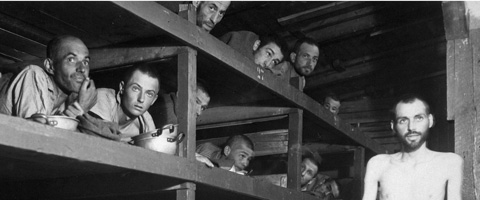Memories of war and liberation
Concentration camp liberators share their stories with Baylor's Institute for Oral History
At the end of World War II, a young Army chaplain named Wilson Canafax was among the soldiers who traveled to Nazi concentration camps with little idea what to expect. Moments after he got out of his Jeep at newly liberated Buchenwald, an emaciated Jewish survivor approached.
"A young fellow came up to me speaking perfect English. He looked to be about 15," recalled Canafax, now a Fort Worth pastor. "He asked 'Could you do us a favor?'"
The young man's plea was simply that Canafax conduct a Jewish worship service.
Canafax and other Texans who liberated European concentration camps are telling their stories in video interviews with Dr. Stephen Sloan, BBA '90, MA '98, director of the Institute for Oral History at Baylor University. The two-year project to produce audio and video recordings of Texans' role is funded by the Texas Holocaust and Genocide Commission. It educates citizens to increase understanding of the past and encourage individual responsibility for society's actions. Transcripts will be given to libraries in the liberators' hometowns, the liberators' families and Holocaust museums in El Paso, Dallas, Houston and San Antonio.
"This is not just one story," Sloan said. "It's everything from guilt to pride in being able to contribute to the liberation to shaken faith to utter incapacity to process anything they saw."
Buchenwald was liberated in April 1945. But for many of the prisoners liberated -- more than 20,000 people, some 4,000 of them Jews, according to historical accounts -- there was no quick, orderly exit.
"You've heard the expression 'Dead man walking.' That's the way -- I don't like to use the word inmate, I don't like to use the word resident -- that's the way they looked," Canafax told Sloan. "I planned a worship service for them, a Jewish worship service ... So many of them wanted nothing to do with religion. But some came, and I met with them several times for services."
Many could not walk and were transported by military "Carryall" vehicles to a place of worship.
"They had to be lifted on, carried on, crying," Canafax said in the interview. "We had some little prayer books -- I wish I had mine now -- that were distributed among those that wanted them. One side was Hebrew prayers; the other side was English. I could follow along in English. They cried; they shouted.
"When they got through, they just were raising their hands sort of like our Pentecostals today," he said. "They were just raising their hands in joy and appreciation. They didn't think they'd ever see that again. They didn't think they'd be alive. That was it. I didn't think much about doing that because that's the regular work of a chaplain. I got through, went back to my outfit, kept on going in my chaplaincy."
But certain images were seared into Canafax's memory. Among them was a room at Buchenwald with hooks on the walls, nearly ceiling-high, later described in historical accounts as extermination rooms. Such silent testimonies to hatred, as well as a sense of inadequacy, sparked a crisis of faith for Canafax.
Sloan's interviews are being recorded by videographer and Baylor graduate student Robert DeBoard. Among them are a Corpus Christi soldier, a liberator of Dachau. The soldier held a Jewish victim of the concentration camp in his arms for two hours, feeding him diluted C-rations to try to keep him alive.
DeBoard said recording the interviews "has been an amazing experience ... This was a man who came running onto a beach at Normandy, like in Saving Private Ryan. You can't imagine them having seen what they saw ... When you hear them talking about it and remembering it really well, it's something else entirely from reading about it."
If you or a Texan you know helped liberate a concentration camp and want to be part of the project, please contact Dr. Stephen Sloan at Baylor's Institute of Oral History at (254) 710-6290 or Stephen_Sloan@baylor.edu.
